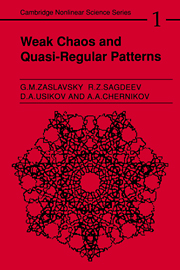4 - Stochastic layer to stochastic sea transition
Published online by Cambridge University Press: 29 October 2009
Summary
The picture of the onset of chaos, as we see it today, is so extremely complex that one is advised to assume a step-by-step approach in its comprehension, temporarily omitting certain questions from consideration. In the preceding chapter, nothing was said of the border between the stochastic layer and the region of invariant curves. For that reason, in calculating the width of the stochastic layer, we adopted the approximate inequality K ≳ 1 as the border of chaos. Of course, the question of the conditions of the onset of chaos emerged as soon as the first studies on the analysis of real physical systems appeared. The word ‘real’ here means ‘typical’ for many physical problems, since there are strict mathematical criteria of chaos which can be illustrated by not-too-abstract models (Note 4.1). The main feature shared by these ‘chosen’ cases is the absence in phase space of sandwich-like or hole-riddled structures in which regions of chaos alternate with regions of stability. Examples of the first and second type are presented in Figs. 3.4.1 and 4.0.1, respectively: the ‘stochastic sea’ (the shaded area) is made up of points of the mapping belonging to a single trajectory, while the light regions are islands that cannot be reached by a trajectory from the sea region, and vice versa.
The coexistence of stability regions and regions of chaos in phase space presents severe problems in the study of dynamical chaos (Note 4.2). This difficulty comes up, for example, in the structure of the stochastic sea.
- Type
- Chapter
- Information
- Weak Chaos and Quasi-Regular Patterns , pp. 58 - 85Publisher: Cambridge University PressPrint publication year: 1991



